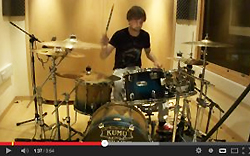Drum mikiing is an art form you might be missing. How many drum microphones do you really need? Do you have that many mixer channels to spare? Are you feeding your drummer the right mix?
Four microphones might be all you need.
My current stage setup includes an acoustic drum kit with eight microphones. Eight? Mmmm, that sounds about right. The larger the room, the more control you want over the drums.
What I mean by that statement is that in small rooms, you can get a lot of stage volume out of your drums without mics. I occasionally work in a small venue with ZERO drum mics…and it works because the room is small enough.
The eight microphones are easy to fill up when you have mics for the kick, snare, individual toms, cymbals, high-hat, and then the overheads. This gives great control of the whole drum kick and allows me to emphasize different parts of the drum kit depending on the needs of the song.
But what about when you don’t have enough channels, or enough mics, or wonder if you really even need that many in your room?
Welcome Glyn Johns
Glyn Johns is a recording artist who has worked with many of the big name bands from the classic rock era. He is even attributed to giving the Eagles their distinct sound.
One of the innovations in drum miking came from him and is called the Glyn Johns Technique.
This technique uses only FOUR microphones for capturing a full drum kit. I’ve even it seen using three, but for today, we’ll use four.
The first dynamic microphone is placed 6-to-12 inches from the resonance head of the kick drum. Gotta mic the kick!
The next two mics are used as overhead microphones. The first of these should be about 4 feet over the snare and it should capture the full sound of the drum kit.
The second overhead isn’t really on overhead at all but the idea is the same. Place it to the right of the floor tom, about 6 inches above the floor tom head and pointed directly at the snare drum. Consider it a side-fill mic that gives you a different kit sound. Use condenser mics for these two “overheads.”
Finally, mike the snare a few inches above the head.
You now have two overhead microphones that capture the full drum kit and you have control over the kick and snare. When mixing, bring in the overheads, mix those for the best blend, and then add in the kick and snare for filling out the mix as needed.
How does it sound? I found this unique video of someone playing with the Glyn Johns Technique to a Paramore song, minus the drum tracks. Enjoy.
Monitoring
What about the drummer? Pipe out an overhead to his monitor. Then, as needed, bring in the kick and the snare.
The key to making this work is in having the overheads capture the full kit sound. You don’t want them to be too heavy on one kit piece.
Ready to learn and laugh? Chris Huff writes about the world of church audio at Behind The Mixer. He covers everything from audio fundamentals to dealing with musicians, and can even tell you the signs the sound guy is having a mental breakdown. To view the original article and to make comments, go here.





















